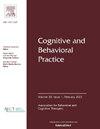延长悲伤治疗
IF 2.9
3区 心理学
Q1 PSYCHOLOGY, CLINICAL
引用次数: 0
摘要
本文简要介绍了延长悲伤疗法(PGT),这是一种基于证据的治疗方法,适用于DSM-5和ICD-11中新的PGD诊断。PGD不同于非临床悲伤,也不同于重度抑郁症和创伤后应激障碍。PGD症状对抑郁症的治疗反应不大。PGD合并症预示创伤后应激障碍的治疗结果更差。我们的小组在20世纪90年代中期开始描述PGD,使用“创伤性”或“复杂”悲伤的术语,并开发和测试一种治疗这种疾病的方法。我们在2005年发表的随机试验成为第一个经经验验证的治疗这种疾病的方法。它的前提是,悲伤是对失去亲人的自然反应,在亲近的人去世后,悲伤会持续一段不确定的时间。它的前提是,悲伤是对失去亲人的自然反应,随着失去亲人的人学会在一个缺失的世界中生活,悲伤会逐渐发展和消退。PGD是这一学习过程中障碍的结果,治疗的目的是促进学习与失去一起生活,并解决这一过程中的障碍。最近PGD被纳入DSM-5使得许多临床医生不熟悉PGD,我们验证的治疗方法,测试治疗的研究以及学习和使用这种方法的方法。本文提供了这些主题的简要总结。本文章由计算机程序翻译,如有差异,请以英文原文为准。
Prolonged Grief Therapy
This paper provides a concise introduction to Prolonged Grief Therapy (PGT), an evidence-based treatment for the new PGD diagnosis in DSM-5 and ICD-11. PGD differs from nonclinical grief as well as major depression and PTSD. PGD symptoms show little response to treatments for depression. PGD comorbidity predicts worse treatment outcome for PTSD. Our group began describing PGD in the mid-1990s, using the terms “traumatic” or “complicated” grief, and to develop and test a treatment for this condition. The publication in 2005 of our randomized trial became the first empirically validated treatment for this condition. It is based upon the premise that grief is the natural response to loss that continues for an indefinite period of time after someone close dies. It is based upon the premise that grief is the natural response to loss that evolves and subsides as a bereaved person learns to live in a world of absence. PGD is the result of impediments to this learning process and the treatment aims to facilitate learning to live with a loss and to address impediments to this process. The recency of its inclusion in DSM-5 leaves many clinicians unfamiliar with PGD, the treatment that we validated, the studies in which the treatment was tested and the ways available to learn and use this approach. This paper provides a brief summary of each of these topics.
求助全文
通过发布文献求助,成功后即可免费获取论文全文。
去求助
来源期刊

Cognitive and Behavioral Practice
PSYCHOLOGY, CLINICAL-
CiteScore
4.80
自引率
3.40%
发文量
118
审稿时长
84 days
期刊介绍:
Cognitive and Behavioral Practice is a quarterly international journal that serves an enduring resource for empirically informed methods of clinical practice. Its mission is to bridge the gap between published research and the actual clinical practice of cognitive behavior therapy. Cognitive and Behavioral Practice publishes clinically rich accounts of innovative assessment and diagnostic and therapeutic procedures that are clearly grounded in empirical research. A focus on application and implementation of procedures is maintained.
 求助内容:
求助内容: 应助结果提醒方式:
应助结果提醒方式:


